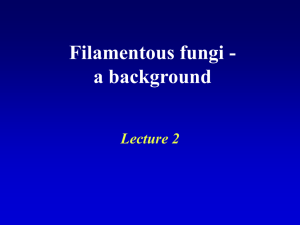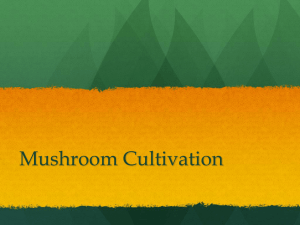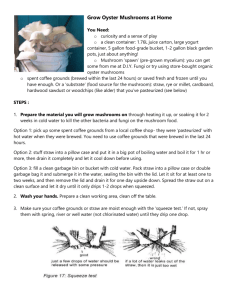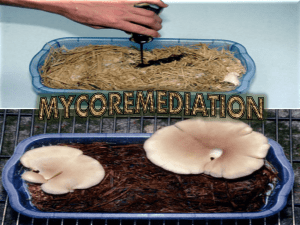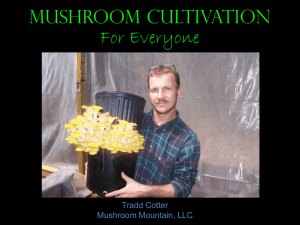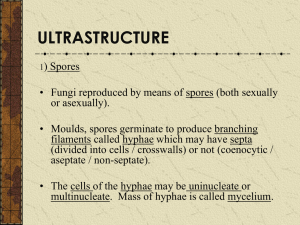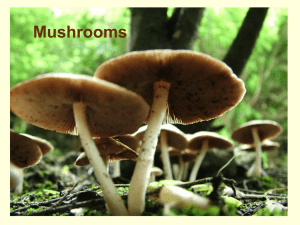SYP Essay
advertisement
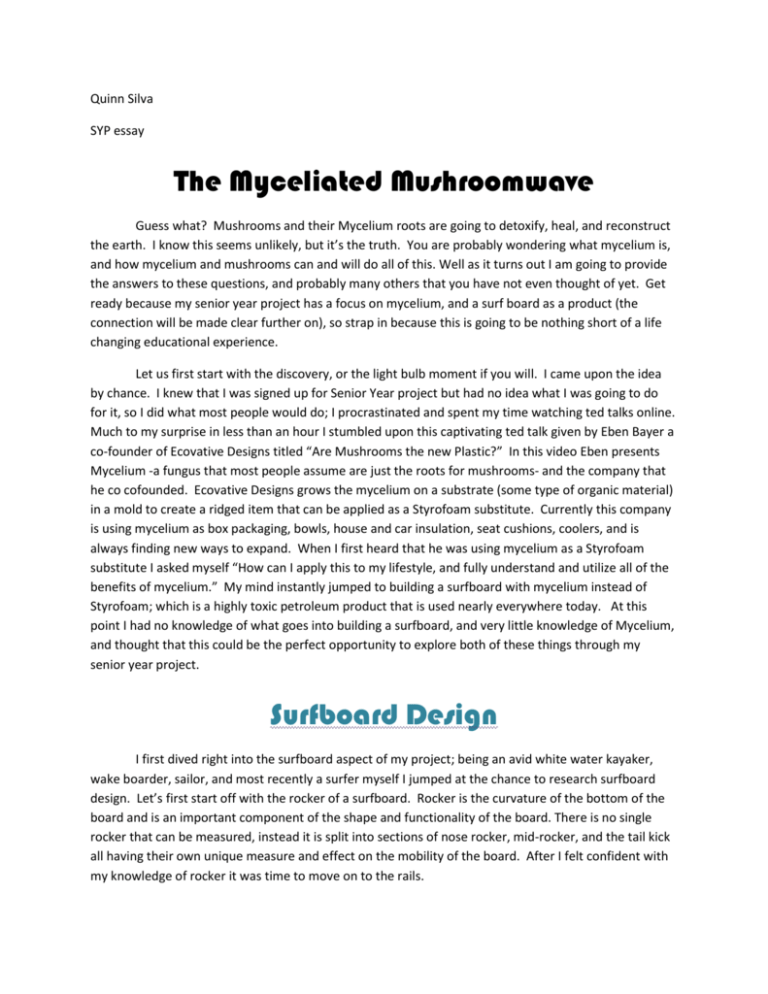
Quinn Silva SYP essay The Myceliated Mushroomwave Guess what? Mushrooms and their Mycelium roots are going to detoxify, heal, and reconstruct the earth. I know this seems unlikely, but it’s the truth. You are probably wondering what mycelium is, and how mycelium and mushrooms can and will do all of this. Well as it turns out I am going to provide the answers to these questions, and probably many others that you have not even thought of yet. Get ready because my senior year project has a focus on mycelium, and a surf board as a product (the connection will be made clear further on), so strap in because this is going to be nothing short of a life changing educational experience. Let us first start with the discovery, or the light bulb moment if you will. I came upon the idea by chance. I knew that I was signed up for Senior Year project but had no idea what I was going to do for it, so I did what most people would do; I procrastinated and spent my time watching ted talks online. Much to my surprise in less than an hour I stumbled upon this captivating ted talk given by Eben Bayer a co-founder of Ecovative Designs titled “Are Mushrooms the new Plastic?” In this video Eben presents Mycelium -a fungus that most people assume are just the roots for mushrooms- and the company that he co cofounded. Ecovative Designs grows the mycelium on a substrate (some type of organic material) in a mold to create a ridged item that can be applied as a Styrofoam substitute. Currently this company is using mycelium as box packaging, bowls, house and car insulation, seat cushions, coolers, and is always finding new ways to expand. When I first heard that he was using mycelium as a Styrofoam substitute I asked myself “How can I apply this to my lifestyle, and fully understand and utilize all of the benefits of mycelium.” My mind instantly jumped to building a surfboard with mycelium instead of Styrofoam; which is a highly toxic petroleum product that is used nearly everywhere today. At this point I had no knowledge of what goes into building a surfboard, and very little knowledge of Mycelium, and thought that this could be the perfect opportunity to explore both of these things through my senior year project. Surfboard Design I first dived right into the surfboard aspect of my project; being an avid white water kayaker, wake boarder, sailor, and most recently a surfer myself I jumped at the chance to research surfboard design. Let’s first start off with the rocker of a surfboard. Rocker is the curvature of the bottom of the board and is an important component of the shape and functionality of the board. There is no single rocker that can be measured, instead it is split into sections of nose rocker, mid-rocker, and the tail kick all having their own unique measure and effect on the mobility of the board. After I felt confident with my knowledge of rocker it was time to move on to the rails. The rail of a surf board is where the deck of the board and the bottom meet; rail design determines how responsive the board will be and how well it will accelerate. The rail is where the water flows over the side of the board so different shapes will yield different results. A soft or more rounded rail is seen more on a long board, or stand-Up paddle board (SUP for short) because it is more stable and tracks better, but sharper rails are more for pivoting, and achieving the acceleration needed for tricks. Tail design is where the rider experiences the most freedom, and control over their board. The general rule for tail design is that the shape matches the turn. If the tail is sharp and angular then the rider will be able to make very sharp and aggressive turns, but if the tail is rounded the rider will have smoother circular turns. The relationship of tail kick-which allows the rider to pivot the nose end upand tail design – which determines the type of turn the board will easily make- that gives the rider their freedom of style, and range of tricks they can achieve. The final component of surfboard design is the fin placement and design. Fin design and placement complements the tail design and kick by influencing the tracking, and maneuverability of the board. The thickness of the fin as well as the angle it presents itself from the center of the board, and from the bottom of the board alike influence drag, and tracking. A fin that is thicker will have more drag but will allow the board to track better (seen more on long boards), and a fin that angles out from the bottom but tilts inward towards the center will give the rider more of a response when turning as well as reduced drag. All things considered the more experience a surfer has the more they can mix and match different rockers, rails, fins, and tail designs to create the ultimate surfboard for their needs and interests. With so many aspects of the surfboard to customize riders have more freedom now than ever to find (or build) a board that is perfect for their riding abilities, and style. Mycelium in Depth After gathering all of this information about surfboard design, and functionality I stopped and thought “Wait I still don’t know much at all about Mycelium!” As I franticly researched mycelium I was only able to get spotty information, most of which was about cooking and farming mushrooms and not Mycelium. However there was this one name; Paul Stamets that kept coming up in every search. He had written a book that seemed to have a focus on mycelium called “Mycelium Running” so I figured that he must be the brain on Mycelium and went out and purchased his book. After two days of reading this book, my entire life had been changed and my brain was on overload with information, questions, and amazement for all of the applications of mycelium. Let’s first start off with how plants and animals use Mycelium to their advantage. The relationship between two organisms directly working together for some net benefit (usually to prevent infestation by parasites and to gather nutrients) is called mutualism. It is common to see insects such as termites and ants cultivating mushrooms. Both use Mycelium, and mushroom beds for incubation of their larvae (Image on right). Since certain fungi function as natural bactericides and fungicides (Via the enzymes naturally produced by their mycelium), some insects have taken them on as allies in an effort to counter infections from harmful bacteria and other fungi. Studies at Oregon state university (Currie et al. 2003) show that Attine ants, which include leaf cutters, grow Lepiota Mycelium as hosts for a harmless bacteria that produces an antibiotic against destructive microfungal parasites (Escovopsis sp.), and they also feed Lepiota Mycelium to their larvae. There is a specific mycelium referred to as Endophytes that are benevolent, nomycorrhizal(mycelium does not wrap around the roots) fungi that partner with many plants, from grasses to trees. Endophyte Mycelia thread between the cell wall but do not actually enter the cell, this enhances the plants ability to grow and absorb nutrients, while thwarting parasites, infections, and avoiding attacks from insects, other fungi, and herbivores. Endophytes have grown well in laboratory conditions but many naturally occurring Endophytes seem to have lost their ability to produce spores, and therefore mushrooms, and spend their life in a continuous Mycelial state. Below you can see a picture of a plant cell and the endophytes wrapping around, and in-between cells but not actually entering the cell. An example of an experiment where endophytes were found to be beneficial to plants was; In a 2003 experiment in Panama, researchers found that when endophyte free leaves from the chocolate producing cocoa tree were inoculated with endophytes, leaf necrosis and mortality declined threefold, suggesting a biodefensive effect is possible against the other pathogens such as Phytophthora, the genus responsible for sudden oak death-a disease devastating California's native Oak population. (Arnold et al. 2003) Different species of these Endophytes can have other applications. For example the Curvularia species is a fungus qualified as an extremophile (a thermally tolerant species that grows in harsh environments where life is hard to find) and allows some tolerance to drought and heat to the host plant. The effects of Curvularia spores on plants may expand the biological tool set for Mycorestoration, possibly even drastically expanding oasis environment and countering desertification. (Stamets P. 2005) Some Endophyte fungi can become competitive with blight (a type of fungi that is parasitic and rots wood and lives off of the host) and overcome it. Pulverized mixtures of Sclerotium (a compact mass of hardened Mycelium, with stored food) also known as Chaga can be packed into infected trees to heal and eradicate the blight. Medical Benefits of Mycelial Enzymes Mushrooms and their mycelium are beneficial not only to plants (and forests on a large scale), but also humans as an active defense against harmful insects, infection from bacteria, and harmful fungi (usually parasitic). Mushrooms and Humans are similar in the way that we both need to fight off infection from bacteria, and parasites. Humans take the defensive and create antibodies to attack infections and bacteria after they are in our system, whereas mushrooms and their mycelia take the offensive and produce a whole host of enzymes that ward off these unwanted enemies. With increasing pollution and disease it is imperative that we protect the natural habitats of these mushrooms in old growth forests, because not only will the Mycelial bed filter out pollutants but many of our medicines today have their roots in mushrooms. Estimates are that two-thirds of our pharmaceuticals still originate from nature. (Stamets 2005) Natural medicines such as taxol, discovered in the bark of Pacific yew trees, help chemists to manufacture similar compounds for treating deadly diseases like ovarian and other cancers. Another example is Paul Stamets's discovery that an extract from the polypore mushroom Formitopsis officinalis protects human blood cells from infection from orthopox viruses, the family that includes small pox. Collins and Ng (1997) identified a polysaccharopeptide from turkey tail (Trametes versicolor) mushrooms inhibiting HIV type 1 infection. Eo and others (1999,2000) found antiviral activity in the methanolsoluble fractions of Reishi mushrooms (Ganoderma lucidum) that selectively inhibit herpes simplex 1 and 2, and the vesicular stomatitis virus (VSV) (see tables 1-3 in the Appendix extracted from Paul Stamets book “Mycelium Running”) What causes this? It can’t just be happening on its own? The answer is NATURE every time! The cell surface of the Mycelium in essence "sweats" out antibacterial enzymes that are known to scientists as exudates, or secondary metabolites (produced in the metabolism process that is not necessary for reproduction or directly related to growth). To name a few useful antibiotics isolated in mushrooms look at the table presented below. Mushroom Calvatia gigantea(Giant puffballs) Armillaria mella(Honey mushroom) Agaricus campestris (Meadow mushroom) Coprinus species (Inky caps) Trametes versicolor (Turkey tail) Lentinula elodes (Shiitake) Ganoderma lucidum(Reishi) Fomitopsis officanlis(Agarikon) Sparassis crispa (Cauliflower) Antibiotic Calvacin Armillaric Acid Campestrin Coprinol Corolin Cortinellin Gnaomycin Agaricin Sparassol The fact that Mushrooms inhibit some bacteria but not others shows that Mycelium influences the makeup of microbial populations in its immediate ecosystem. (Stamets 2005). All of these medical benefits that are readily available to us through Mycelium make it mandatory that we protect mushrooms and preserve their natural habitat. Below you can see an image of strands of mycelium “sweating” out the enzymes that we are able to apply to medicine. Mycorestoration Mycorerestoration is the use of fungi to repair or restore the weakened immune systems of a given environment. Mycorerestoration involves using fungi to filter water (Mycofiltration), to enact Ecoforestry policy (Mycoforestry), or co-cultivation with food crops (Mycogardening), to denature toxic wastes (Mycoremediation), and to control insect pests (Mycopesticides). In this essay I’m going to highlight Mycofiltration, Mycoremediation, and Mycopesticides. Mycofiltration Mycofiltration is the use of Mycelium as a web-like medium for filtering out micro-organisms, pollutants, and silt. Mycelium forms this thread like network of interlacing cells that weave within one another, this network, web, bed whatever you would like to call it catches particles and in some cases digest them. As the substrate (a supporting organic material on which Mycelium can grow) debris is digested, micro-cavities form and fill with air or water providing a buoyant, aerated structure withan extensive surface area. The natural enzymes (the antibacterial “sweat” mentioned in the medical benefits section above) that Mycelium produces may not digest all of the pathogens that may be in the soil, but some bacteria such as Bacillus subtilis(a catalase bacteria that is known to compromise immune systems) are blocked from reproducing and are forced into dormancy. Mycofilters seem complex, and complicated, but what I want to know is; how are they used? What application do they have that can benefit us? Mycelial filters have many applications because they can filter pathogens including protozoa, bacteria, and viruses, as well as silt and chemical toxins. Mycofilters can be set up in a number of locations such as; farms and suburban and urban areas, watersheds, factories, roads, and in stressed or harmed habitats. Mycelium has the amazing ability to mineralize substrates (mycelial enzymes break down and release minerals from a solid compound like granite or stone), this means that soil that was previously rocky and dry is turned into a looser and more compatible medium for plants and animals. This process is the first step for mycelium to transform barren habitats filled with dry soil and rocks into a nutrient rich environment where ecosystems can thrive. The physical Mycofilter can be created in several ways, but the use of a mycelial bed or bunker spawn are more commonly used and are very effective. A mycelial bed is essentially made of an organic substrate (usually woodchips) that is inoculated with mycelium and spread over the desired landscape. A mycelial bed functions similarly to a medicated Band-Aid in that it patches a wounded area, cleans the wound, and allows the environment to heal itself. The inoculated woodchips are spread over the area it is intended to heal, and the mycelium in the woodchips kills bacteria, removes harmful toxins in the soil and breaks down large rocks into smaller ones. After a few months (especially in the rainy months of spring) mushrooms will pop up release spores, die, are digested by the mycelium and contribute to a healthy nutrient rich new layer of top soil acting like a scab. As this processes cycles a few times over the soil will be healthy with low levels of toxins and bacteria so it can support plant and animal life alike. Bunker spawn is another method used; they are normally seen piled up stream or just off the coast to catch any pollutants before they can be carried downstream. When spawn (mycelium inoculated substrate) is mixed into materials such as wood chips, and stuffed into burlap sacks (made of jute, hemp, cotton, or wood fibers), a portable living mycelium “pod” is made. Using burlap bag spawn, homeowners can create Mycological landscapes in their back yards. On a larger scale, this type of spawn can help repair damage to ecosystems, and can create buffers between sensitive ecosystems and toxic environments. Immediately upon construction, these spawn bags filter biological or chemical wastes and prevent downstream contamination due to colonized wood chips' extensive surface areas and their absorptive abilities. As the Mycelium grows, its web-like structure increasingly traps silt and bacteria, and the "sweat" of the Mycelium denatures many toxins, both chemical and biological. (Stamets 2005) Here you can see two pictures the one on the left is an illustration of bunker spawn being used, and on the right is a picture of an active bunker spawn set up just off shore to prevent pollutants in the water reaching the shore. As these pods break down they will drop decomposed and nutrient rich soil which can help prevent and counter beach erosion of lakes and ponds protecting the plant life and animal habitats on shore. If you are thinking about setting up a Mycofilter there are some things that you should consider before doing so. To determine which species of mushroom to use just look around and see what species has taken residency in the area; those mushrooms have already been selected by nature to be the most compatible for the environment. Considering the characteristics of the pathogens present is also important, does it appear seasonally or is it constantly active? Rain and seasonal weather patterns have a major influence on the out flow rate of contaminated surface water. Around cattle and pig feedlots the flow of coliforms, nitrates, and phosphorus affects the downstream watershed, especially during the local rainy season. By creating a sheet-mulch (mycelial bed), with shallow compost 6 inches to 2 feet thick, the Mycofiltration properties of the Mycelium and surface areas of the mycelial bed will trap and denature the harmful outflow of toxins from the farm. Mycological landscapes must be replenished with an organic substrate, as well as spawn in order to preserve the saprophytic mushroom communities. The constant falling of tree branches and leaves in the forest not only stimulates and feeds saprophytic mushrooms, the very decomposition of these materials and mushrooms alike add depth, health, and nutrients to the soil. Mycoremediation The next step in Mycorestoration is very exciting, it is called Mycoremediation. Mycoremediation is the use of fungi to degrade or remove toxins from the environment. Some fungi produce powerful enzymes that can digest lignin and cellulose, which are the primary structural components found in wood. These enzymes can break down a wide range of toxins that have chemical bonds similar to those in wood. White rot fungi, which are more abundant and produce stronger enzymes are more effective and therefore better to use for Mycoremediation. Below is a table of common white rotter mushrooms. Since many of the bonds that hold plant materials together (carbon, hydrogen, oxygen, and sometimes phosphorus) are similar to the bonds found in petroleum products including diesel, oil, and many herbicides and pesticides, Mycelial enzymes are well suited for decomposing a wide spectrum of toxic chemicals. Since the Mycelial enzymes break down the Hydrogen-Carbon bonds, the predominant fluid by-product leaves the mycelium and the mushroom in the form of carbon dioxide and water. (Stamets 2005) The enzymes secreted by the White fungi group's Mycelia include lignin(also found in wood, which is why mushrooms can grow so well on tree stumps and wood chips) peroxides, manganese peroxides, and laccases. (Schlipake et al. 2003) Common White-Rot fungi Scientific Name Pleurotus ostreatus Grifola frondosa Trametes versicolor Ganoderma lucidum Ganoderma applanatum Phanerochaete chrysosporium Common Name The Oyster Maitake Turkey Tail Reishi Artist Conk Crust Fungus Since mycelium is responsible for the flow of nutrients in an environment, all other life in that area are dependent on the mycelium in the soil to keep a balance or equilibrium to survive. Once saprophytic mushrooms breakdown the residing toxins in their environment, they then move on to provide a new layer of nutrient rich soil which causes a rush of synergistic animals that can now grow and thrive in the non-toxic soil. This new layer of soil is created by the action of bacteria using the mushrooms as a nutrient source to aid in their own growth. These same microbes break down and digest the saprophytic mushrooms into a healthy, nutrient rich soil that boosts the strength of the surrounding environment. The best spawn to use to carry out a Mycoremediation agenda would be “Natural Spawn”, which is spawn (inoculated substrate) that has had exposure to the local microbes and a specialized defense against them. This pre-exposure gives the spawn a natural advantage that “Pure Spawn” (created under sterilized conditions) wouldn’t have because Natural spawn has already built its armor against microbes present in the surrounding environment unlike the pure spawn which has only been present in sterile conditions. An example of where we can apply Mycoremediation is in cleaning up oil spills. Mycelium is inoculated onto human hair, which is then placed in a nylon or burlap bag and laid on the spill. The hair absorbs the oil and provides an organic substrate for the Mycelium to latch onto, from there the oil can be saprophytized by the Mycelium. Bioremediation and Mycoremediation eliminate the expense incurred in removing thousands of tons of tainted soil to a remote toxic site that won't fix the problem just hide it. Paul Stamets conducted an experiment with the Washington state department of transportation that proves the success of mycelium for detoxifying soils. Paul Stamets conducted this experiment while working with Battelle; WSDOT operated a maintenance yard for trucks for more than 30 years. Diesel and oil contaminated the soil at levels approaching 2 percent, or 20,000 parts per million (ppm) of total aromatic hydrocarbons, or TAHs. Paul and the team from Battelle set aside 4 piles of diesel contaminated soil, placing them onto 4 large sheets of 6 mm black plastic polyethylene at the maintenance yard. Each pile measured about 3 to 4 feet in height, 20 feet in length, and 8 feet in width. Into one of the piles (measuring about 10 cubic yards), he mixed about three cubic yards of pure culture sawdust spawn, an amount roughly equal to 30 percent of the pile (the sawdust spawn was placed in layers which was tested to show better Mycoremediation results). The other piles received no Mycelia. Of these piles 2 were given bacterial treatments and 1 was an untreated control. The Myceliated pile was covered with a shade cloth, while black plastic tarps covered the other piles to keep the rain out. About 4 weeks later, part of the team returned to the site and pulled the black tarps off, only to reveal black lifeless dirt piles that stank of diesel and oil. Then they pulled of the shade cloth of the Myceliated pile only to be shocked! The Myceliated pile yielded hundreds of oyster mushrooms some of them measuring more than 12 inches in diameter (such an abundant crop is only seen where the nutrition is especially rich). This pile was now light brown covered with mushrooms and did not smell of diesel or oil. After nine weeks vascular plants had appeared and were thriving! Between weeks 4-9 the original oyster mushrooms had died and were digested by mycelium and turned into a new, healthy layer of soil that attracted insects, which then attracted birds which means that potentially if let alone this pile could have created a new habitat for an array of animals. Battelle researchers reported that the total petroleum hydrocarbons (TPHs) had been decreased from 20,000 ppm to less than 200 ppm in just 8 weeks, making the soil acceptable for freeway landscaping. (Stamets 2005) Below is a picture of the Myceliated pile of dirt exploding with oyster mushrooms. Paul Stamets and the team from Battelle took this principle one step further with the idea of familiarizing mushroom strains to a nonnative wood substrate so that the mushroom mycelium could adapt its enzymatic pathways early in its life cycle. From there they then expanded the model with promising strains to using toxins instead of wood as added nutrients in the media the strains were being grown in. In the end they were able to customize strains so that they neutralized toxic weaponized chemicals and waste. They were able to find mushroom strains with enzymes for making and breaking phosphorus bonds, the critical bonds that hold nerve gas toxins together. Once the enzymes broke the phosphorus bonds, they theorized the toxin would decompose into nontoxic form. This is in fact what happened with several of the strains provided in chart 4 of the appendix. Many mushrooms absorb radio activity and some are even hyperaccumulators which means they have a peculiar ability to take in and concentrate elements such as cesium at thousands of times above levels in the surrounding area. It is common for a toxic waste site to have multiple contaminants, and if heavy metals are present some mushrooms (hyperaccumulators) will concentrate them and make them toxic. Harvesting these mushrooms could gradually reduce cadmium, mercury, arsenic, led and even radioactive elements such as cesium-134 and 137 (common by-products of nuclear weapon and energy industry). It is easy to collect the toxins once they are inside the mushroom in solid form, from there you can take the metal/toxin laden mushrooms to a waste site where they can recycle and extract the metals. Arica and fellow researchers (2003) applied Mycoremediation to clean water leaching from heavy-metal contaminated soil; they used turkey tail and phoenix Mycelia to remove 97% of mercury ions from water. By combining the water with small beads composed of Mycelia, which selectively absorb mercury, and a salt that speeds up the transfer of ions from the water to Mycelia called alginic acid. The live Mycelium of some fungi produces organomercury lyases, enzymes that break down organomercury into HgO by mercuric reductase (Gadd 1993). Once separated, mercury can unimolecularily bond with selenium (another metal that mushrooms concentrate via up-channeling). Fungi can precipitate many metals around their Mycelia, such as silver, selenium, telluride, cadmium, lead, and others. Mycopesticides Pesticides were invented to fight destructive insects and protect crops and structures. However, many of the chemicals used in pesticides, especially the organophosphates, harm non-targeted organisms, pollute water, and impair human health. The need for alternative, nontoxic pesticides is imperative, since the medical and ecological impact of toxic pesticides poses an increasing health hazard and is damaging Earth. The search for reasonable and environmentally friendly methods to control insects has focused on biopesticides-nature based remedies that cause only negligible collateral damage or none at all, to other organisms. Nearly all insects feed off of, live with, or die via some form of fungi. Not all fungi are insect friendly; thousands of species of fungi (called entomopathogenic) are aggressive and are known to attack many insect species. Species in the genus Metarhizium (especially Metarhizium anisopliae), Beauveria (epically Beauveria bassiana); and a handful of species in the genus Paecilomyces, are the ones researchers focus on the most. When insects come into contact with spores from these entomopathogenic fungi, the spores attach to the insects and grow through the insects' exoskeletons using chitin(polymer found in the cell walls of fungi, and the exoskeletons of anthropods and insects)dissolving enzymes. Once inside the insect the mycelium stretches its way through the internal organs, which interferes with the metabolism causing starvation, infection, and death. After just a few days the mycelium mummifies the insect from the inside out, as seen in the picture below. One species of Cordyceps (Cordyceps lloydii), when it infects a carpenter ant, compels the insect to climb to the canopy of the Costa Rican cloud forest where it resides. Once it has reached the top of the canopy the ant locks its jaw into a leaf and dies. Shortly after its death a Cordyceps mushroom pops out of its head. As of now researchers do not know what chemical reaction causes this zombie walk to the canopy, but they do know that by reaching the canopy the mushroom is capable of releasing spores further because the wind will carry them unlike the mushrooms on the forest floor. Nature has built up a defense for possible wide spread infection and death within a colony because their survival depends on it. In groups of social insects, spore carrying workers are refused entry to the nest, with several layers of guards thwarting their efforts. (Stamets 2005) If infected ants are refused entry to the nest how can the mycelium be introduced in ways that will sneak through these check points? Paul Stamets figured that a way to get the infected ants past the guards would be to create a non sporulating state in Metarhizium or Beauveria that does not have the smell of sporulating mushrooms, but instead contains an attractant and a feeding stimulant. Since insects avoid known lethal spores, attracting them to presporulating insecticidal fungi has many advantages including, that the insects themselves become agents for dispersing the fungi throughout the colony. How much is this all costing? The rot alone from these pests is burning a hole through our pockets as well as toxifying our environment. The damage, primarily to buildings, caused by native subterranean termites in the United States alone exceeds $10 billion per year, while the damage from imported Formosan termites exceeds $1 billion annually. Whole neighborhoods, and even entire cities such as New Orleans, are being consumed. That city loses $300 million per year to termites, with forecasts of greater damage as the colonies move further into the city. The market value of the pesticide industry in the United States has swelled to $9 billion; of that 5 percent or $450 million is from biopesticides. The biopesticide market share is increasing 15 percent per year. Several companies have expended a great deal of money to develop spore delivery systems but fumigating houses is no longer a viable option and contact pesticides are not efficient and have a very small likely hood of killing the queen. However, termites that contracted the Mycelium then recruited other individuals to travel into the presporulating Mycelium, who then recruited more, etc. The compounding effect of recruitment means that little Mycelium can go a long way, as opposed to contact poisons such as pyrethrins, which quickly kill the insects before they can return to the colony and therefore must be used in large amounts, but could still miss a few including the queen not solving the problem.(Stamets 2005) Bringing it all Together Now we have come nearly to the end; we started with the desire to learn about building and designing surfboards, and wanting to dig deeper into the world of mycelium. Now that all of the layers of back-round information have officially been gathered, and organized I can finally answer your likely question of “How does this all relate? I mean a surfboard and mushrooms? What’s the deal here?” Well it all comes back to Eben Bayer and the team at Ecovative designs with their application of mycelium as a Styrofoam substitute. First off, how bad is Styrofoam really? Styrofoam is a trademark of the Dow Chemical Company for a closed-cell extrused polystyrene foam, that is currently made for insulation, various craft applications, surfboards, and padding for boxing items. Polystyrene is a liquid hydrocarbon that is manufactured from petroleum, and is a widely used plastic that sells billions of kilograms per year. The production of one ton of Styrofoam requires 685 US gallons (2,593 liters) of oil, and emits about 20,00094,000 tons of CO2 and 2,055.8 tons of greenhouse gases. Styrofoam is uneconomical to recycle and is a death sentence for any bird or sea creature that ingests it. The U.S. Environmental Protection Agency (EPA) states on its website: "Each year Americans throw away 25,000,000,000 Styrofoam cups. Even 500 years from now, the foam coffee cup you used this morning will be sitting in a landfill.” Unfortunately for most surfers their Styrofoam surfboard is not the full extent of their toxic foot print, as it turns out the common resins and epoxies used to glass a surfboard are also toxic. When epoxy resin systems are used, single molecules (monomers) of the epoxy resin chemical and the curing agent combine to form long chains of molecules (polymers). As the mixture "cures" it becomes a hard polymer. Some epoxies cure in a few minutes at room temperature. Others need additional time or heat to harden. The characteristics of hardened epoxies (such as whether they are firm or flexible, or resistant to heat or chemicals) depend on which epoxy monomers, curing agents, solvents, and fillers are added. The hardened, finished polymers are almost non-toxic; it is exposure to the uncured resin components that can be harmful. Single-component systems are usually safer, because the hazardous chemicals are already partly combined into less toxic polymers and because they do not evaporate into the air as easily. Epoxy resins can cause eye, nose, throat, and lung irritation presenting itself with headaches and asthma like symptoms. It can also cause some itchiness or redness on the skin; prolonged exposure can result in blistering or more intense redness. Prolonged exposure can also result in nervous system damage that has the same symptoms as alcohol intoxication; slurred speech, dizziness, confusion, headache, and possible loss of consciousness. Pretty gnarly huh? My solution is to build my own wooden surfboard that could potentially have a mycelium core, or potentially be entirely made of mycelium (in the same idea of Eben Bayer has for using Mycelium as a structural Styrofoam substitute). The surfboard I plan to build will be hollow wood (Balsa and Paulina), with a bamboo fiber coating sealed with a non-toxic green epoxy and bio-resin. This way my surfboard foot print will be minimal and when my board has finally given up I can rest easy at night knowing that it will not toxify the earth I am living on, and responsible for. P.S. Should I ever take this to the next level and make a business out of Mycelium surfboards, I have a very rough idea of how to keep more boards out of landfills and to highlight the cradle to cradle life style by reducing consumption of materials, reusing them, and recycling. Here is the scenario; surfer comes in with a broken mycelium board, they give us specifications for a new board and we take their broken board and let them select a “loaner” board. We then take the old broken board grind it up and use it as a substrate for mycelium to grow them another board. After the mycelium grows we can shape the board to their specifications. This means that a surfer can in essence use the same surfboard for life that they started with, or at least a part of their original board will transfer with each succession and reincarnation of their board. By doing this we are ensured a good customer base if not on the idea alone, but eventually the boards will break and they can throw it away where it will biodegrade in a few years or we can build them another board from their original, it’s a win either way. We are keeping Styrofoam out of landfills and are offering a green and innovative solution to an everyday problem that everyone can breathe easy about.


